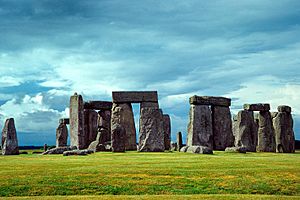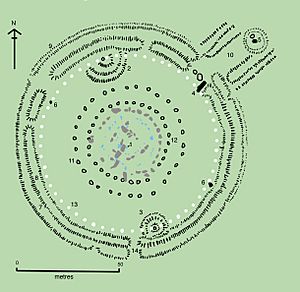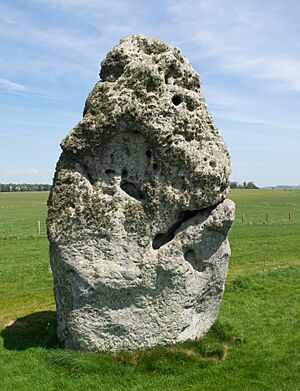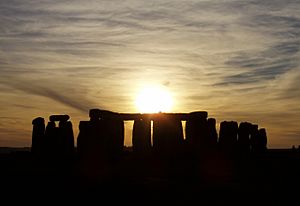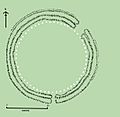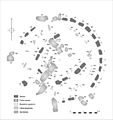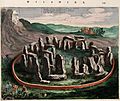Stonehenge facts for kids
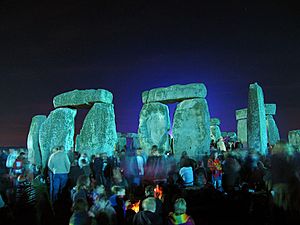
Stonehenge is a very old and famous World Heritage Site in England. It's made of huge stones called megaliths. You can find it about 13 kilometers (8 miles) north of Salisbury in Wiltshire.
People built Stonehenge between 3100 BC and 1550 BC. It was used until the Bronze Age. The monument has a henge (a circular ditch and bank) with standing stones arranged in circles. It's one of the most important prehistoric sites in Britain. Many people have visited it for a very long time.
Contents
Building Stonehenge
Stonehenge was built in three main stages. Most of the work happened between 2640 and 2480 BC.
First Stage: Digging and Pits
The first stage began around 3100 BC. During this time, people dug a circular ditch and a bank. They also dug a ring of 56 pits. These pits are known as Aubrey Holes.
Second Stage: Bluestones Arrive
The second stage started around 2100 BC. The builders of Stonehenge brought huge pillars of rock from Southwestern Wales. They set these rocks up in concentric (one inside another) circles. These circles were around the center of the site. This double circle was never finished. It was taken apart during the third building period.
Final Stage: Giant Sarsen Stones
The last stage probably ended before 1500 BC. During this time, the monument was changed. Builders put up a circle of 30 tall stones. Each of these stones weighed up to 50 tons. A ring of stone lintels (horizontal stones) sat on top of them. Inside this circle, they made a horseshoe shape with five pairs of upright stones. Each pair also had a stone lintel on top.
Scientists have studied DNA from ancient people. They found that the Stonehenge builders came from the area that is now Turkey.
History of the Stones
The Bluestones
The first stone circle was made of 'bluestones'. These stones are a type of igneous rock called dolerite.
The Stonehenge builders dug holes for up to 80 standing bluestones. Today, we can only find 43 of them.
There are different theories about how these bluestones got to Stonehenge. The long-distance human transport theory says that people brought the bluestones from the Preseli Hills in Wales. This is about 260 km (160 miles) away from Stonehenge! In 2011, a bluestone quarry (where stones are dug up) was found in Wales. This discovery supported the idea that people moved the stones.
Another idea is that a huge Irish Sea Glacier (a giant sheet of ice) carried the stones close to Stonehenge. However, there is no proof that glaciers left stones in southern central England. So, this theory is not as widely believed.
The Sarsen Stones
Later, around 2400 BC, the builders brought thirty huge grey sarsen stones to the site. These are large sandstone blocks. They 'dressed' (shaped) the stones. They used special joints like mortice and tenon joints to fit them together.
They set these sarsen stones in a circle about 33 meters (108 ft) wide. A ring of 30 lintel stones rested on top. The lintels were joined using another method, like a tongue and groove joint. The remaining bluestones were then placed in an inner circle. Each standing sarsen stone was about 4.1 meters (13 ft) tall and 2.1 meters (6 ft 11 in) wide. They weighed about 25 tons each.
These sarsen stones might have come from a quarry about 40 km (25 miles) north of Stonehenge. It's also possible they were collected from natural piles of sarsens closer by. Today, Stonehenge is made entirely of its original stones. Some of them have been put back upright.
Fun Stories and Legends
The Heel Stone
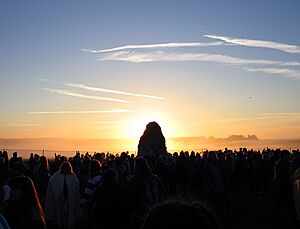
The Heel Stone is a rough stone northeast of the sarsen circle. It's about 16 feet (5 meters) above the ground and leans towards the stone circle. It has been called "Friar's Heel" and "Sun-stone" in the past.
At the Summer solstice (the longest day of the year), if you stand inside the stone circle and look northeast, the Sun rises in the direction of the Heel Stone. Many photos show the Sun rising over it.
There's a folk tale about the name "Friar's Heel":
The Devil bought the stones from a woman in Ireland. He wrapped them up and brought them to Salisbury plain. One stone fell into the Avon. The rest were carried to the plain. The Devil then shouted, "No one will ever find out how these stones came here!" A friar replied, "That's what you think!" The Devil then threw one of the stones at him and hit him on the heel. The stone stuck in the ground and is still there.
King Arthur's Legend
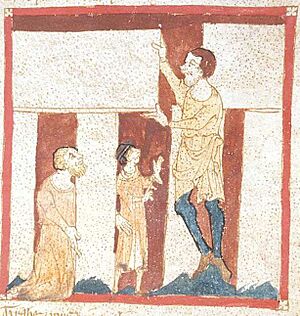
A book from the 1100s, Historia Regum Britanniae (History of the Kings of Britain), tells a magical story. It says that the wizard Merlin helped bring Stonehenge from Ireland.
The story says the stones of Stonehenge were healing stones. giants had brought them from Africa to Ireland. They were set up on Mount Killaraus as a stone circle. This was known as the Giant's Ring. King Aurelius Ambrosius wanted to build a memorial for British nobles killed by the Saxons. Merlin told him to use the Giant's Ring. The king sent Merlin and Uther Pendragon (who was King Arthur's father) with 15,000 men to get the stones. They won against an Irish army, but they couldn't move the huge stones. With Merlin's magic, they moved the stones to Britain. Then they set them up again just as they had been.
Even though this story is fiction, archaeologist Mike Parker Pearson thinks it might have a "grain of truth." This is because evidence suggests the Stonehenge bluestones really did come from a stone circle in Wales, near the Irish Sea.
Another legend says that a Saxon king named Hengist invited British warriors to a feast. But he tricked them and had his men kill 420 of them. Hengist then built Stonehenge on that spot to show he was sorry.
Nearby Sites
Stonehenge is not alone! There are other ancient sites nearby. These include passage tombs (old burial places) and many tumuli (burial mounds).
Stonehenge also has several other structures that are part of its 'ritual landscape':
- Bluehenge: A new discovery, about one mile southeast.
- Durrington Walls: A Neolithic (New Stone Age) settlement, two miles northeast of Stonehenge.
- Normanton Down Barrows: A burial ground from the Neolithic and Bronze Age.
- Stonehenge Avenue: A path that leads two miles from Stonehenge to Bluehenge on the River Avon.
- Stonehenge Cursus: The largest monument in the area, but it's hard to see on the ground.
- Woodhenge: Found in 1925 from an aerial survey. It had a henge and a wooden circle.
What Was Stonehenge For?
No one knows for sure who built Stonehenge or why they built it. However, during the summer solstice, the sunrise lines up with some of the stones in a special way. This makes many people think that the stones might have worked like a calendar. Similar ancient buildings in Egypt and South America also show the time of the solstice.
Some scientists believe that ancient people could predict eclipses of the sun and moon. They might have done this by watching how the sun and moon moved in relation to Stonehenge. The site may have been an observatory (a place for watching the sky). It might also have been a place where rituals or religious ceremonies took place on certain days of the year.
The Crown of England owns Stonehenge. English Heritage manages it. The land around it belongs to the National Trust.
The World Heritage Site actually includes both Avebury and Stonehenge. They are quite different, but both are very important.
Visiting Stonehenge
When Stonehenge first opened to the public, people could walk among the stones and even climb on them. But in 1977, ropes were put up because the stones were getting damaged. Visitors are no longer allowed to touch the stones. However, you can walk around the monument from a short distance away.
English Heritage does allow special access during the summer and winter solstice. They also allow it during the spring and autumn equinox. You can also book special visits to get closer to the stones throughout the year. About 30,000 local people can visit Stonehenge for free. This is part of an agreement from 1921.
Related pages
Images for kids
-
Graffiti on the sarsen stones include ancient carvings of a dagger and an axe
-
Sunrise at Stonehenge on the summer solstice, 21 June 2005
-
10th Battalion, CEF marches past the site, winter 1914–15 (WW I); Background: Preservation work on stones, propped up by timbers
See also
 In Spanish: Stonehenge para niños
In Spanish: Stonehenge para niños


